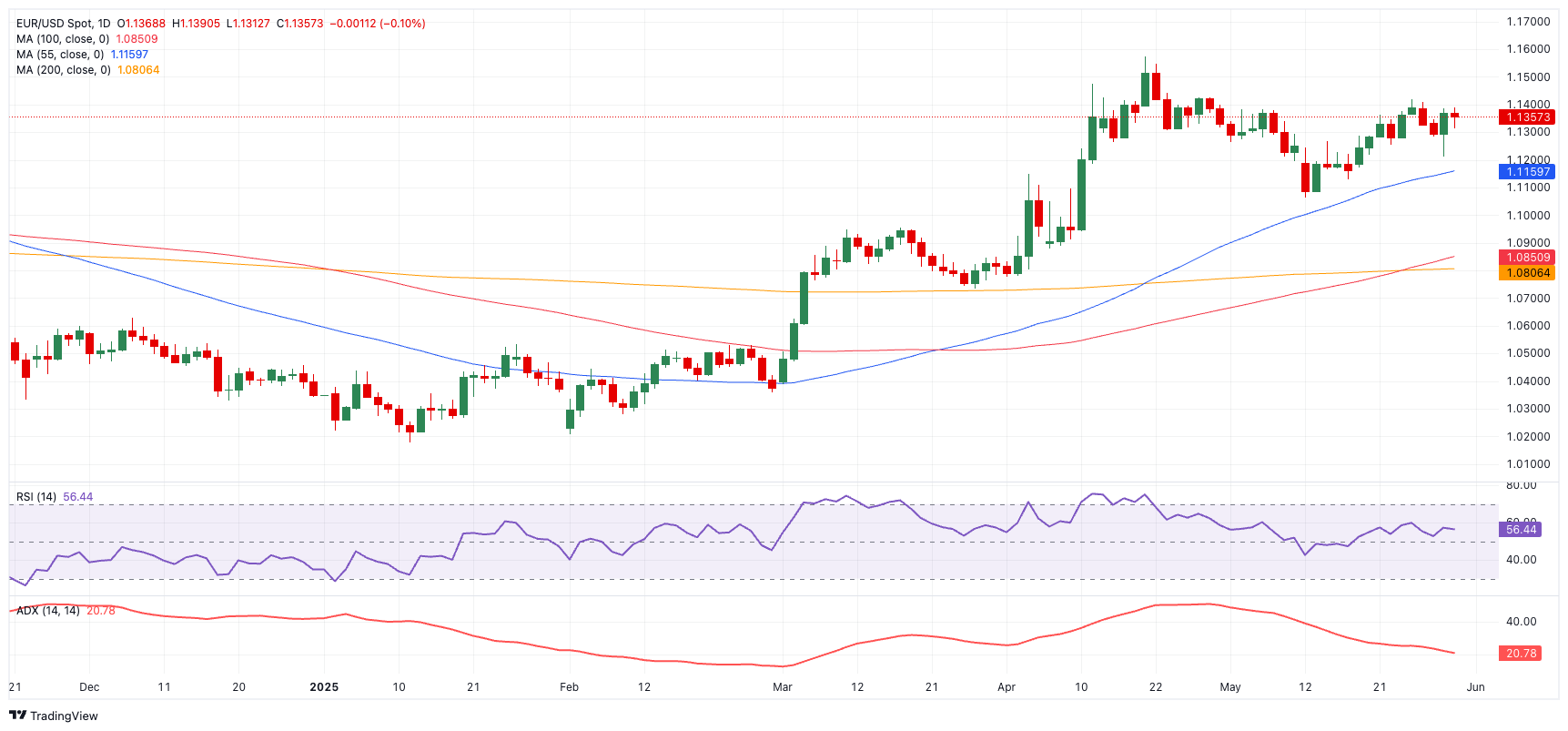- EUR/USD clocked weekly losses, with gains capped by 1.1400 so far.
- The US Dollar managed to rebound slightly on the weekly chart.
- The ECB could lower its policy rate for the last time this year next week.
The Euro (EUR) traded in a choppy fashion throughout the week, prompting EUR/USD to end slightly on the defensive on the weekly chart.
The pair’s price action came in response to an equally erratic performance in the US Dollar (USD). Unlike EUR/USD, the US Dollar Index (DXY) managed to clock a humble advance over the last five days, although quite southwards of its weekly peaks around 100.50.
Looking at the money markets on both sides of the ocean, US yields seem to have embarked on a consolidative phase at the upper end of the monthly range. Meanwhile, in Germany, 10-year bund yields traded on a downward path, managing to meet decent contention around the key 2.50% zone for the time being.
Once again, the debate among market participants gyrated around the US trade policy, although this time with a slight tweak.
“Optimism vs. scepticism” is the name of the game on the trade front
Most of President Donald Trump’s tariffs were barred by a US trade court judgement on Wednesday, which declared the president had overreached his power by placing uniform taxes on imports from American trading partners.
Indeed, the US Constitution grants Congress sole jurisdiction to control trade with other nations, a power that is not superseded by the president’s emergency powers to defend the US economy, according to the Court of International Trade (CIT).
However, on Thursday, a federal appeals court temporarily restored the most broad of his tariffs.
Ordering the plaintiffs in the cases to respond by June 5 and the government by June 9, the United States Court of Appeals for the Federal Circuit in Washington said it was halting the lower court’s ruling to consider the government’s appeal.
All in all, the news did nothing but add to the lack of clear direction in the White House’s trade policies that has been prevailing since practically “Inauguration Day”.
Let’s recall that nothing else, neither progress nor deterioration, has been heard after the United States recently clinched trade agreements with both China and the United Kingdom.
From a more macro viewpoint, the still ongoing trade tensions between the world’s two largest economies, alongside President Trump’s decision to impose tariffs on several other countries, have disrupted global supply chains, rattled financial markets and raised concerns over a potential slowdown in global economic growth.
Policy divergence puts Euro on the defensive
The Federal Reserve (Fed) opted to maintain interest rates at their current level in May, despite the backdrop of decreasing inflation and ongoing trade uncertainties. Two cuts are anticipated by year’s end, with implementation expected to begin in September.
The latest Minutes have disclosed that the Fed is confronting “difficult trade-offs” amid rising inflation and unemployment, alongside estimates indicating an increased risk of recession. The interplay between inflation and unemployment presents a critical challenge for central bank authorities, who must weigh the decision of implementing tighter monetary policy to address inflation against the option of lowering interest rates to stimulate growth and enhance employment opportunities.
On the opposite side of the road, the European Central Bank (ECB) lowered its deposit rate by 25 basis points to 2.25% at its May event.
Market consensus is anticipating a further quarter-point rate cut as soon as next week, driven by persistently low inflation and growing concerns regarding US tariffs.
Technical outlook: Heavy resistance looms
EUR/USD remains capped beneath its 2025 high of 1.1572 (April 21). Beyond that, key resistance lies at the 1.1600 limestone, ahead of the October 2021 top of 1.1692.
On the downside, interim contention sits at the 55-day simple moving average (SMA) at 1.1165, with deeper cushions at the more significant 200-day SMA at 1.0813 and the weekly trough at 1.0732 (March 27).
Momentum indicators suggest some consolidation might be in store. The Relative Strength Index (RSI) has eased to the vicinity of 54, while the Average Directional Index (ADX) is near 21 points, indicating a modest and possibly shrinking trend momentum.
EUR/USD daily chart

Outlook: It is all about trade
The Euro’s future remains clouded by competing forces. While the widening Fed-ECB policy gap and USD resilience may continue to weigh on the single currency, the prospect of lower trade tensions and an improvement in the geopolitical landscape should support the EUR. Against this, further consolidation is in the cards, at least until some clarity on the trade path emerges and both the Fed and the ECB provide more information on their plans for the coming months.
Euro FAQs
The Euro is the currency for the 19 European Union countries that belong to the Eurozone. It is the second most heavily traded currency in the world behind the US Dollar. In 2022, it accounted for 31% of all foreign exchange transactions, with an average daily turnover of over $2.2 trillion a day.
EUR/USD is the most heavily traded currency pair in the world, accounting for an estimated 30% off all transactions, followed by EUR/JPY (4%), EUR/GBP (3%) and EUR/AUD (2%).
The European Central Bank (ECB) in Frankfurt, Germany, is the reserve bank for the Eurozone. The ECB sets interest rates and manages monetary policy.
The ECB’s primary mandate is to maintain price stability, which means either controlling inflation or stimulating growth. Its primary tool is the raising or lowering of interest rates. Relatively high interest rates – or the expectation of higher rates – will usually benefit the Euro and vice versa.
The ECB Governing Council makes monetary policy decisions at meetings held eight times a year. Decisions are made by heads of the Eurozone national banks and six permanent members, including the President of the ECB, Christine Lagarde.
Eurozone inflation data, measured by the Harmonized Index of Consumer Prices (HICP), is an important econometric for the Euro. If inflation rises more than expected, especially if above the ECB’s 2% target, it obliges the ECB to raise interest rates to bring it back under control.
Relatively high interest rates compared to its counterparts will usually benefit the Euro, as it makes the region more attractive as a place for global investors to park their money.
Data releases gauge the health of the economy and can impact on the Euro. Indicators such as GDP, Manufacturing and Services PMIs, employment, and consumer sentiment surveys can all influence the direction of the single currency.
A strong economy is good for the Euro. Not only does it attract more foreign investment but it may encourage the ECB to put up interest rates, which will directly strengthen the Euro. Otherwise, if economic data is weak, the Euro is likely to fall.
Economic data for the four largest economies in the euro area (Germany, France, Italy and Spain) are especially significant, as they account for 75% of the Eurozone’s economy.
Another significant data release for the Euro is the Trade Balance. This indicator measures the difference between what a country earns from its exports and what it spends on imports over a given period.
If a country produces highly sought after exports then its currency will gain in value purely from the extra demand created from foreign buyers seeking to purchase these goods. Therefore, a positive net Trade Balance strengthens a currency and vice versa for a negative balance.

